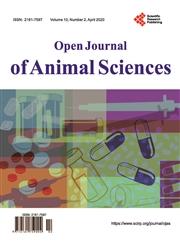Evaluating a Three-Fold Continuum of Fry Stocking Density for Rearing Walleye in Lined Ponds
引用次数: 0
Abstract
Fry stocking density can affect harvest metrics for fingerling walleye (Stizostedion vitreum) reared in drainable ponds, but few studies have examined these relationships with the use of elevated walleye fry stocking densities in lined ponds. Correlation and regression analyses were used to assess how a three-fold change in walleye fry stocking density (234,375 to 703,125 per hectare) relates to harvest metrics and length of the culture period, as well as the tradeoff experienced between walleye size (grams) and harvest density in 0.32hectare lined ponds over a nine-year period at Blue Dog State Fish Hatchery, South Dakota. As fry stocking density increased, so did harvest metrics for both number (r = 0.85, P < 0.01) and yield (r = 0.81, P < 0.01). Length of the culture period varied between 24 and 35 days and was negatively related to stocking density (r = −0.66, P < 0.01). The linear relationship between harvest density and yield was highly correlated (r = 0.95, P < 0.01) with highest values measuring 617,625 walleye and 173 kilograms per hectare. Harvest density explained 61% of the variation in walleye size (P < 0.01) and exhibited a decreasing curvilinear relationship such that continued increases in harvest density resulted in smaller reductions in fish size. Increasing fry stocking density from 234,375 to 703,125 per hectare in lined ponds coincided with increased rearing efficiencies for number and yield, as well as a reduced culture period. Minimal reduction in walleye size occurred once harvest density exceeded 300,000 per hectare.衬砌池塘养殖中眼鱼苗放养密度的三倍连续度评价
鱼苗放养密度会影响排水塘中养殖的青眼鱼苗(Stizostedion vitreum)的收获指标,但很少有研究调查这些指标与在有排水塘中提高青眼鱼苗放养密度之间的关系。使用相关和回归分析来评估南达科他州蓝狗州立鱼孵化场0.32公顷衬里池塘中白眼鱼苗放养密度(每公顷234,375至703,125)的三倍变化与收获指标和养殖期长度之间的关系,以及9年期间白眼鱼苗大小(克)和收获密度之间的权衡。随着鱼苗放养密度的增加,鱼苗数量(r = 0.85, P < 0.01)和产量(r = 0.81, P < 0.01)的收获指标也随之增加。培养时间为24 ~ 35 d,与放养密度呈负相关(r = - 0.66, P < 0.01)。收获密度与产量呈高度相关(r = 0.95, P < 0.01),最高收获密度为617,625眼/公顷,最高收获密度为173公斤/公顷。捕捞密度对鱼眼大小变化的贡献率为61% (P < 0.01),且呈递减曲线关系,即捕捞密度的持续增加导致鱼眼大小的减小幅度较小。将鱼苗放养密度从每公顷234,375增加到每公顷703,125,同时增加了数量和产量的饲养效率,并缩短了养殖周期。一旦收获密度超过每公顷30万只,眼孔眼大小就会出现最小程度的减少。
本文章由计算机程序翻译,如有差异,请以英文原文为准。
求助全文
约1分钟内获得全文
求助全文

 求助内容:
求助内容: 应助结果提醒方式:
应助结果提醒方式:


